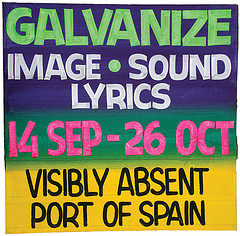Saturday, January 04, 2003
Does Guyana simply take its literature more seriously than the rest of us? The Stabroek News today, for no particular apparent reason, runs an editorial summing up the achievement of Wilson Harris (long excerpt below but no link, because Stabroek has no permanent online archive).
His extraordinarily innovative work is unusual often to the point of bewilderment in its apparent jettisoning of traditional conventions of prose writing. However, for the reader "who requires more of fiction than mere skilful figure-skating over the surface of life" (Robert Nye), Harris's fiction offers real rewards. These include an unfashionably positive and life-enhancing view of human potential in a world dangerously polarised along implacable racial, political and cultural fault-lines, as well as a philosophical and cultural challenge of global significance....
His work has gained the admiration and respect of even his harshest critics for the depth and consistency of his attempt to extend the boundaries of the novel, forging a new, often startling fictional language and style. Entering a Harris novel is always a challenge, never an "easy read". Harris often takes the conventional, deliberately tilting it, virtually capsizing explicit meaning into apparent non-sense so as to allow implicit, new meaning to emerge....
From his first novel, Palace of the Peacock (1960) to his most recent, The Dark Jester (2001), his 23rd novel, the Guyanese/South American rainforest appears as a major influence in his work, which might be described as a painting in progress, a vast canvas that, like the work of Abdias do Nascimento of Brazil, or Leroi Clarke of Trinidad, or Aubrey Williams of Guyana, is constructed through a series of incremental, contradictory and often confusing images and ideas which resolve themselves into a pattern of astonishing relevance and clarity when taken as a whole, experienced by the reader without any attempt at coercion of the text. A good novel, after all, like a good painting, isn't merely something we read passively. It reads us.
Like the Cuban writer Alejo Carpentier or Colombia's Gabriel Garcia Marquez, Harris had found a "magical reality" reflected in the Caribbean/South American landscape of rivers and rainforests. It was his experience of the Guyana rainforest (where he spent several years as a hydrographic surveyor) which alerted him to the need to "read" the landscape differently. The landscape of the rainforest, he realised, could not be explicitly described: one couldn't, for example, simply call the trees "green", nor the rivers "black", because there are continually changing shapes, shades and colours in that landscape which require a less rigid, more open-ended method of description. The landscape itself was often unpredictable and challenging: the mirror-like surface of a river or creek might contain rocks or "tacoubas" waiting just below the surface to capsize the confident steersman. It was this sense, by extension, of the fluid, unstable nature of life itself, of the need to develop an "interior" validity, that led him to repudiate the essentially colonial "novel of persuasion" in which the writer consolidates his characters — persuades us to believe in their life-like portrayal — and set him off on a difficult but more rewarding journey.
Harris also saw (like Denis Williams) that in Guyana and the Caribbean, there was no static, fixed or immediately recognisable identity, especially in Guyana, owing to the country's racial and cultural mix and to what Denis Williams had called "the lack of assurance of an indwelling ancestor". The human person, for Harris, therefore, was a welter of possibilities, wearing many faces like the landscape itself, offering a theme of a "living drama of conception" rather than the explicit Naipaulian portraiture of the broken Caribbean person. Racial admixture, the horror of slavery, the detritus of Empire, could then become (as it did for Derek Walcott, who has also fashioned a major reconstructive art out of the shards of Caribbean racial and cultural history), a source of infinite possibilities, and a new art of fiction would be needed to reflect this new approach to the human condition....
His is a remarkable, cross-cultural imagination that discovers the seeds of regeneration within the rubble of colonial conquest and "lost" El Dorados, excavating through dream, myth and allegory the enduring potential of the human spirit. It is easy to complain of the "difficulty" of reading Wilson Harris's work, but unwise to ignore its importance.
(Worth noting that Denise de Caires-Narain, daughter of Stabroek's editor & publisher David de Caires, is a noted Harris scholar. She is also chair of the judging panel for this year's Guyana Prize for Literature.)
I must admit I'm one of those readers who have found it "easy to complain of the 'difficulty' of reading Wilson Harris's work". Friends whose judgement I have no reason to distrust assure me that Harris is on a plane with Joyce; well, Finnegans Wake has defeated me more than once, & I persist in finding Palace of the Peacock essentially unreadable. But I do not underestimate Harris's significance. His influence is undeniable, & influence is the fundamental canonical value. (Right, Uncle Harold?)
His extraordinarily innovative work is unusual often to the point of bewilderment in its apparent jettisoning of traditional conventions of prose writing. However, for the reader "who requires more of fiction than mere skilful figure-skating over the surface of life" (Robert Nye), Harris's fiction offers real rewards. These include an unfashionably positive and life-enhancing view of human potential in a world dangerously polarised along implacable racial, political and cultural fault-lines, as well as a philosophical and cultural challenge of global significance....
His work has gained the admiration and respect of even his harshest critics for the depth and consistency of his attempt to extend the boundaries of the novel, forging a new, often startling fictional language and style. Entering a Harris novel is always a challenge, never an "easy read". Harris often takes the conventional, deliberately tilting it, virtually capsizing explicit meaning into apparent non-sense so as to allow implicit, new meaning to emerge....
From his first novel, Palace of the Peacock (1960) to his most recent, The Dark Jester (2001), his 23rd novel, the Guyanese/South American rainforest appears as a major influence in his work, which might be described as a painting in progress, a vast canvas that, like the work of Abdias do Nascimento of Brazil, or Leroi Clarke of Trinidad, or Aubrey Williams of Guyana, is constructed through a series of incremental, contradictory and often confusing images and ideas which resolve themselves into a pattern of astonishing relevance and clarity when taken as a whole, experienced by the reader without any attempt at coercion of the text. A good novel, after all, like a good painting, isn't merely something we read passively. It reads us.
Like the Cuban writer Alejo Carpentier or Colombia's Gabriel Garcia Marquez, Harris had found a "magical reality" reflected in the Caribbean/South American landscape of rivers and rainforests. It was his experience of the Guyana rainforest (where he spent several years as a hydrographic surveyor) which alerted him to the need to "read" the landscape differently. The landscape of the rainforest, he realised, could not be explicitly described: one couldn't, for example, simply call the trees "green", nor the rivers "black", because there are continually changing shapes, shades and colours in that landscape which require a less rigid, more open-ended method of description. The landscape itself was often unpredictable and challenging: the mirror-like surface of a river or creek might contain rocks or "tacoubas" waiting just below the surface to capsize the confident steersman. It was this sense, by extension, of the fluid, unstable nature of life itself, of the need to develop an "interior" validity, that led him to repudiate the essentially colonial "novel of persuasion" in which the writer consolidates his characters — persuades us to believe in their life-like portrayal — and set him off on a difficult but more rewarding journey.
Harris also saw (like Denis Williams) that in Guyana and the Caribbean, there was no static, fixed or immediately recognisable identity, especially in Guyana, owing to the country's racial and cultural mix and to what Denis Williams had called "the lack of assurance of an indwelling ancestor". The human person, for Harris, therefore, was a welter of possibilities, wearing many faces like the landscape itself, offering a theme of a "living drama of conception" rather than the explicit Naipaulian portraiture of the broken Caribbean person. Racial admixture, the horror of slavery, the detritus of Empire, could then become (as it did for Derek Walcott, who has also fashioned a major reconstructive art out of the shards of Caribbean racial and cultural history), a source of infinite possibilities, and a new art of fiction would be needed to reflect this new approach to the human condition....
His is a remarkable, cross-cultural imagination that discovers the seeds of regeneration within the rubble of colonial conquest and "lost" El Dorados, excavating through dream, myth and allegory the enduring potential of the human spirit. It is easy to complain of the "difficulty" of reading Wilson Harris's work, but unwise to ignore its importance.
(Worth noting that Denise de Caires-Narain, daughter of Stabroek's editor & publisher David de Caires, is a noted Harris scholar. She is also chair of the judging panel for this year's Guyana Prize for Literature.)
I must admit I'm one of those readers who have found it "easy to complain of the 'difficulty' of reading Wilson Harris's work". Friends whose judgement I have no reason to distrust assure me that Harris is on a plane with Joyce; well, Finnegans Wake has defeated me more than once, & I persist in finding Palace of the Peacock essentially unreadable. But I do not underestimate Harris's significance. His influence is undeniable, & influence is the fundamental canonical value. (Right, Uncle Harold?)
Subscribe to:
Post Comments (Atom)









No comments:
Post a Comment